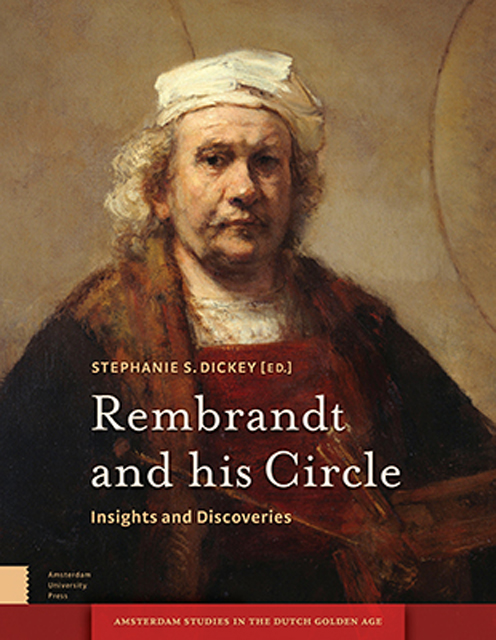Book contents
- Frontmatter
- Dedication
- Contents
- Acknowledgements
- Introduction
- 1 Rembrandt and Frans Hals Painting in the Workshop of Hendrick Uylenburgh
- 2 Rembrandt and the Germanic Style
- 3 Rembrandt and the Humanist Ideal of the Universal Painter
- 4 Curiosity and Desire: Rembrandt’s Collection as Historiographic Barometer
- 5 Painted Landscapes by Lievens and Rembrandt : The View from Seventeenth-Century Amsterdam Collections
- 6 Jan Lievens in Antwerp: Three Rediscovered Works
- 7 Gerrit Dou as a Pupil of Rembrandt
- 8 A New Painting by Jan van Noordt in Budapest
- 9 Rembrandt’s First Nude? The Recent Analysis of Susanna and the Elders from Rembrandt’s Workshop
- 10 Rembrandt’s Head of Christ: Some Technical Observations concerning Matters of Style
- 11 A Rediscovered Head of John the Baptist on a Platter from Rembrandt’s Studio
- 12 Rembrandt’s One Guilder Print: Value and Invention in ‘the most beautiful [print] that ever came from the burin of this Master’
- 13 Rembrandt, Ferdinand Bol, and Tobit: The Emergence of a Pathosträger
- 14 Biblical Iconography in the Graphic Work of Rembrandt’s Circle
- 15 Jan van Vliet and Rembrandt van Rijn: Their Collaboration Reassessed
- 16 Printmaking among Artists of the Rembrandt School
- 17 Chain Line Pattern Matching and Rembrandt’s Prints
- List of Illustrations
- Bibliography
- Index Nominum
9 - Rembrandt’s First Nude? The Recent Analysis of Susanna and the Elders from Rembrandt’s Workshop
Published online by Cambridge University Press: 21 January 2023
- Frontmatter
- Dedication
- Contents
- Acknowledgements
- Introduction
- 1 Rembrandt and Frans Hals Painting in the Workshop of Hendrick Uylenburgh
- 2 Rembrandt and the Germanic Style
- 3 Rembrandt and the Humanist Ideal of the Universal Painter
- 4 Curiosity and Desire: Rembrandt’s Collection as Historiographic Barometer
- 5 Painted Landscapes by Lievens and Rembrandt : The View from Seventeenth-Century Amsterdam Collections
- 6 Jan Lievens in Antwerp: Three Rediscovered Works
- 7 Gerrit Dou as a Pupil of Rembrandt
- 8 A New Painting by Jan van Noordt in Budapest
- 9 Rembrandt’s First Nude? The Recent Analysis of Susanna and the Elders from Rembrandt’s Workshop
- 10 Rembrandt’s Head of Christ: Some Technical Observations concerning Matters of Style
- 11 A Rediscovered Head of John the Baptist on a Platter from Rembrandt’s Studio
- 12 Rembrandt’s One Guilder Print: Value and Invention in ‘the most beautiful [print] that ever came from the burin of this Master’
- 13 Rembrandt, Ferdinand Bol, and Tobit: The Emergence of a Pathosträger
- 14 Biblical Iconography in the Graphic Work of Rembrandt’s Circle
- 15 Jan van Vliet and Rembrandt van Rijn: Their Collaboration Reassessed
- 16 Printmaking among Artists of the Rembrandt School
- 17 Chain Line Pattern Matching and Rembrandt’s Prints
- List of Illustrations
- Bibliography
- Index Nominum
Summary
Abstract
In 1908, the Gemaldegalerie in Berlin acquired an unsigned panel painting entitled Susanna and the Elders, presumably painted by a student of Rembrandt. Until now, this small and, due to its extremely amateur overpainting, rather unattractive painting has gone unnoticed in the literature on Rembrandt. Detailed technical and art historical investigation at the Gemaldegalerie in Berlin revealed that the work had been repeatedly altered and painted over. It turned out that the first stage, probably painted around 1629, was an incomplete female nude by the hand of a young Rembrandt. It was only some years later, presumably after 1636, that the painting was revised, in all likelihood by one of the assistants in Rembrandt's workshop, and made ‘marketable’ as a historical subject by reference to the biblical story of Susanna.
Keywords: Rembrandt van Rijn, Susanna and the Elders, Gemaldegalerie (Berlin), technical art history
In April 1908, the London art dealers Durlacher Brothers offered a painting as a gift to the Kaiser Friedrich Museum in Berlin. The object in question was a small, unsigned panel depicting Susanna and the Elders (fig. 9.1 and pl. 9.1) painted ‘by a student of Rembrandt, perhaps by G. Flinck’. That it was not considered an exceptional product of the Rembrandt workshop was already indicated by the addendum specifying that the donation remain ‘under the value limit of 5000.– Marks’. Nevertheless, Wilhelm Bode accepted the picture for the museum. This perhaps occurred with the rationale that the new acquisition would complement Rembrandt's Susanna and the Elders acquired in 1884 (fig. 9.12 below), which could now be placed beside a student work of a similar subject. The series was completed with Susanna and the Elders by Pieter Lastman (1614), which likewise reached the Gemaldegalerie in 1908. The museum thus possessed three depictions of Susanna by Dutch painters of the seventeenth century, all of whom stood in a master-pupil relationship to each other.
The central motif of the composition is the nude Susanna, who is seated upon a stone covered by a white cloth and turns her brightly lit back to the viewer. Her natural surroundings consist of the bank of a body of water encircled by vegetation.
- Type
- Chapter
- Information
- Rembrandt and his CircleInsights and Discoveries, pp. 197 - 215Publisher: Amsterdam University PressPrint publication year: 2017



